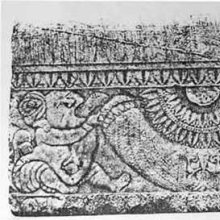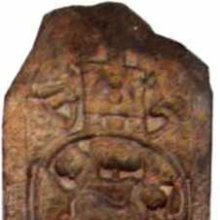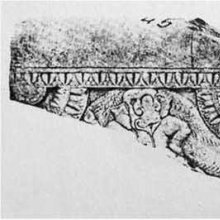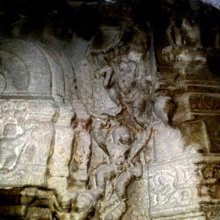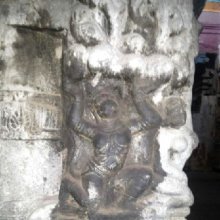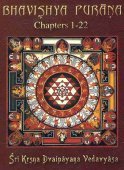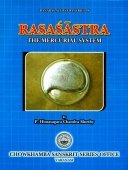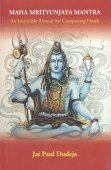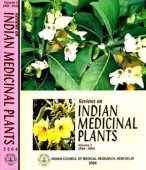Carrying, Carried, Carries: 2 definitions
Introduction:
Carrying means something in Hinduism, Sanskrit. If you want to know the exact meaning, history, etymology or English translation of this term then check out the descriptions on this page. Add your comment or reference to a book if you want to contribute to this summary article.
Images (photo gallery)
(+193 more images available)
In Hinduism
Natyashastra (theatrics and dramaturgy)
Source: Shodhganga: Elements of Art and Architecture in the Trtiyakhanda of the Visnudharmottarapurana (natya)Carrying (the mountain) is associated with Gajadantahasta: one of the thirteen Combined-hand Gestures (in Indian Dramas) (known as saṃyuktahastas), according to the Viṣṇudharmottarapurāṇa, an ancient Sanskrit text which (being encyclopedic in nature) deals with a variety of cultural topics such as arts, architecture, music, grammar and astronomy.—The word gajadanta denotes the danta i.e., tusk of gaja i.e., elephant. In the gajadanta posture, both hands in sarpaśīrṣa position are bent towards each other along with the elbows and shoulders and this posture is used to show carrying the mountain.

Natyashastra (नाट्यशास्त्र, nāṭyaśāstra) refers to both the ancient Indian tradition (shastra) of performing arts, (natya—theatrics, drama, dance, music), as well as the name of a Sanskrit work dealing with these subjects. It also teaches the rules for composing Dramatic plays (nataka), construction and performance of Theater, and Poetic works (kavya).
Yoga (school of philosophy)
Source: ORA: Amanaska (king of all yogas): A Critical Edition and Annotated Translation by Jason BirchCarrying (a skull) is denoted by the Sanskrit term Dharaṇa, according to the Amanaska Yoga treatise dealing with meditation, absorption, yogic powers and liberation.—Accordingly, as Īśvara says to Vāmadeva: “[...] Putting on ochre garments, carrying (kapāla-dharaṇa) a skull, plucking out clumps of hair, maintaining non-vedic religious observances, ashes, ascetic clothing and matted locks, behaving as if mad, [the ascetic practice of] nakedness, [studying] the Vedas, Tantras and so on and the meeting [of learned people] for [reciting] poetry in the assembly: All [this] is exertion for the sake of filling one's stomach and is not the cause of the highest good. [...]”.

Yoga is originally considered a branch of Hindu philosophy (astika), but both ancient and modern Yoga combine the physical, mental and spiritual. Yoga teaches various physical techniques also known as āsanas (postures), used for various purposes (eg., meditation, contemplation, relaxation).
See also (Relevant definitions)
Full-text (+3743): Vahana, Vahin, Vaha, Vivadha, Vahaka, Samvahana, Naravahana, Bharayashti, Pakhalya, Vahaniya, Nirharana, Vahya, Shikya, Striharana, Kshitidharin, Unnatashiras, Upavahana, Apaharaniya, Gangayatra, Nirvaha.
Relevant text
Search found 445 books and stories containing Carrying, Carried, Carries; (plurals include: Carryings, Carrieds, Carrieses). You can also click to the full overview containing English textual excerpts. Below are direct links for the most relevant articles:
Vinaya Pitaka (4): Parivara (by I. B. Horner)
Upāli-Pentads (Division 4: Explanations of Views) < [17. Upāli-Pentads]
19. Second Collection Of Stanzas
The Five Divisions (First Division) < [21. The Five Divisions]
Manusmriti with the Commentary of Medhatithi (by Ganganatha Jha)
Verse 5.100 < [Section XI - Impurity in the case of persons beyond the pale of Sapiṇḍa relationship]
Verse 5.63 < [Section IX - Other forms of Impurity]
Verse 5.103 < [Section XI - Impurity in the case of persons beyond the pale of Sapiṇḍa relationship]
Vinaya (3): The Cullavagga (by T. W. Rhys Davids)
Cullavagga, Khandaka 4, Chapter 12 < [Khandaka 4 - The Settlement of Disputes among the Fraternity]
Cullavagga, Khandaka 1, Chapter 1 < [Khandaka 1 - The Minor Disciplinary Proceedings]
Cullavagga, Khandaka 4, Chapter 11 < [Khandaka 4 - The Settlement of Disputes among the Fraternity]
Vinaya Pitaka (3): Khandhaka (by I. B. Horner)
On revoking an act of suspension for not relinquishing < [9. The monks from Campā (Campeyya)]
Bad character < [14. Settlements (Samatha)]
Duties of one deserving rehabilitation < [12. Probation (Parivāsa)]
The Great Chronicle of Buddhas (by Ven. Mingun Sayadaw)
The Story of Venerable Ambakhadaka Mahā Tissa < [Chapter 6 - On Pāramitā]
Part 4 - Queen Mahā-Māyā’s Journey from Kapilavatthu to Devadaha < [Chapter 1 - The Story of Sataketu Deva, The Future Buddha]
Six and Five kinds of Wrong Livelihood (micchājiva) < [Chapter 6 - On Pāramitā]
Chaitanya Bhagavata (by Bhumipati Dāsa)
Verse 3.2.224 < [Chapter 2 - Description of the Lord’s Travel Through Bhuvaneśvara and Other Placesto Jagannātha Purī]
Verse 1.1.16 < [Chapter 1 - Summary of Lord Gaura’s Pastimes]
Verse 3.5.595-596 < [Chapter 5 - The Pastimes of Nityānanda]
Related products
(+13 more products available)
